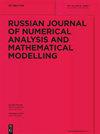基于集总参数法的冠状动脉循环模型边界条件的验证
IF 0.6
4区 数学
Q4 MATHEMATICS, APPLIED
Russian Journal of Numerical Analysis and Mathematical Modelling
Pub Date : 2023-06-01
DOI:10.1515/rnam-2023-0013
引用次数: 1
摘要
在本工作中,我们构建了一个冠状动脉血流模型,该模型同时利用了大冠状动脉的CT扫描和冠状动脉CT灌注。该模型描述了患者冠状血管网络中的脉动流,并考虑了一些生理效应:心肌收缩、血管狭窄、微血管灌注损伤。该模型的主要新颖之处在于新的光滑边界条件,这在以前的患者特异性冠状动脉循环模拟中从未使用过。新的边界条件采用了0 - d集总模型方法,并对具有极细子血管的一对一血管连接和分支的情况提供了解的渐近收敛性。新的边界条件使得更准确地估计分流裕度成为可能。我们还研究了血流动力学指标(分数血流储备、冠状动脉血流储备、瞬时无波比)对微循环损伤变化的敏感性。新模型与原方法在灵敏度上无显著差异。所提出的方法的优点是在日常临床实践中所需数据的可用性,因此,改进了模型的个性化。本文章由计算机程序翻译,如有差异,请以英文原文为准。
Validation of boundary conditions for coronary circulation model based on a lumped parameter approach
Abstract In the present work, we construct a model of coronary flow, which utilizes both CT scans of large coronary arteries and coronary CT perfusion. The model describes pulsatile flow in the patient’s network of coronary vessels and takes into account a number of physiological effects: myocardium contractions, stenoses, impairment of microvascular perfusion. The main novelty of this model is the new smooth boundary conditions that have not been used before in patient-specific simulations of coronary circulation. New boundary conditions use 0D lumped model approach and provide asymptotic convergence of the solution for the cases of one-to-one vascular connection and bifurcation with a very thin child vessel. The new boundary conditions make it possible to estimate the fractional flow margin more accurately. We also studied sensitivity of haemodynamic indices (fractional flow reserve, coronary flow reserve, instantaneous wave-free ratio) to the variations of microcirculation impairment. No substantial difference in sensitivity was observed between new model and original approach. The advantage of the presented approach is the availability of the required data in everyday clinical practice and, thus, improved personalization of the model.
求助全文
通过发布文献求助,成功后即可免费获取论文全文。
去求助
来源期刊
CiteScore
1.40
自引率
16.70%
发文量
31
审稿时长
>12 weeks
期刊介绍:
The Russian Journal of Numerical Analysis and Mathematical Modelling, published bimonthly, provides English translations of selected new original Russian papers on the theoretical aspects of numerical analysis and the application of mathematical methods to simulation and modelling. The editorial board, consisting of the most prominent Russian scientists in numerical analysis and mathematical modelling, selects papers on the basis of their high scientific standard, innovative approach and topical interest.
Topics:
-numerical analysis-
numerical linear algebra-
finite element methods for PDEs-
iterative methods-
Monte-Carlo methods-
mathematical modelling and numerical simulation in geophysical hydrodynamics, immunology and medicine, fluid mechanics and electrodynamics, geosciences.

 求助内容:
求助内容: 应助结果提醒方式:
应助结果提醒方式:


